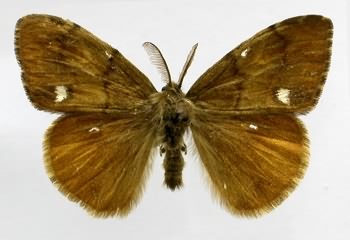Pests
Orgya antiqua Linnaeus - Rusty Tussock Moth, Vapourer Moth.
Systematic position.
Class Insecta, order Lepidoptera, family Lymantriidae, genus Orgyia.Biological group.
Polyphagous pest of fruit crops and forest trees.Morphology and biology.
Sexual dimorphism is strongly pronounced among this species. Male has comb-like antennae, fore wings rusty-brown, with white spot in lower part at external margin (wingspan to 30 mm). Hind wings monochromatic rusty-brown. Female has simple antennae, underdeveloped wings (wingspan 10 to 18 mm) and a thick body of gray color. Fertility reaches 130-350 eggs on the average. Females lay eggs in one batch on surface of their cocoons. Eggs light gray. In the geographic area where only one generation develops, hatching of caterpillars begins in the beginning of May, in Siberia in June. In the geographic area where two generations develop (south of the European part of Russia, Ukraine, Moldova, southern Primorskii Territory) caterpillars hatch at the end of April, in Azerbaijan at the end of March, 3-5 five days prior to the beginning of flowering of apple, and start feeding on leaves. In the beginning they skeletonize leaves and then they eat the round leaf plates at margins, leaving only the petioles and central veins. They can also damage ovaries and young fruits. Caterpillars are gray, with red warts and 5 brushes of long brown hairs. Their period of feeding lasts 25-55 days depending on the zone. Caterpillars of the 2nd generation develop from July until August. Pupation occurs at the end of July in the zone of one generation, in the beginning of July in the zone of two generations, in the beginning or middle of May in the zone of 3 generations; in crowns of trees, in bark cracks on trunks and branches. Pupae are yellow-gray, without wing sheaths, located in a transparent web cocoon. Development of summer pupae takes 7-15 days for males, 10-22 days for females; autumn pupae develop in about 20 days. In September, moths of 2nd generation fly and lay eggs, which diapause until spring.Distribution.
Occurs in Western Europe (except for Far North), Asia Minor, Mongolia, China (including Tibet), Korea, northern America (introduced in the forest zone), in Baltic States, Byelorussia, Ukraine, Moldova, Transcaucasia, Northern Kazakhstan. In Russia it is distributed throughout all of the European part (except for the north), in Altai, Siberia (forest and forest-steppe zones), the Far East (the Amur and Sakhalin Regions, the Khabarovsk and Primorskii Territories).Ecology.
In the former USSR this species has 1 to 3 generations. Females fly in the afternoon; non-flying females usually wait for males on surface of their cocoons, where copulation occurs. Young caterpillars of 1st-2nd instar endure frosts to -5°C. Caterpillars passively migrate for long distances with the help of the wind. Optimum temperature for development of caterpillars (+20°C) and the lower threshold of development (-10°C) were experimentally established. The lower threshold of cold resistance of diapausing eggs during the winter period is -40°C. Sharp fluctuations of temperatures in March and April cause death to 98% of eggs. Different geographical populations have different thresholds of photoperiodic reaction. Degree days in Siberia are 315 degrees for development of male caterpillars, 435 degrees for development of female caterpillars; to the south these parameters are 440 degrees and 540 degrees accordingly. Degree days for development of pupae are 135-200 degrees, degree days for spring egg development are 170 degrees. The pest population is regulated by parasites; Acholcus dolmanni Rtzb is an especially active oviphage.Economic significance.
Polyphagous caterpillars damage fruit and landscape cultures, such as apple, pear, cherry, bird cherry, roses, mountain ash etc., and also forest trees, preferring willow, poplar, birch, larch. They also cause damage to currant, wild-growing rosaceous, maple, linden, cowberry, bilberry. Insignificant damage is reported on clover and soya. In orchards it causes harm in the zone of development of 2 generations. Caterpillars eat round buds, leaves, and flower buds. Control measures include forecast and mating disruption by use of synthetic sexual attractants; if necessary, spraying of insecticides during hatching of caterpillars in foci populated by the pest.Reference citations:
Kuznetsov V.I. 1999. Lymantriidae (Liparidae, Orgyidae). In: Kuznetsov V.I., ed. Insects and mites - pests of agricultural plants. V. 3(2). Lepidoptera. St. Petersburg: Nauka. 279-320 p. (In Russian)Nekrutenko Yu.P. 1974. Lymantriidae. In: Vasil.ev V.P., ed. Pests of agricultural crops and forest plantations. V. 2. Arthropods. Kiev: Urozhai. 357-361 p. (In Russian)
Vasil.ev V.P., Livshits I.Z. 1984. Pests of fruit crops. Moscow: Kolos. 399 p. (In Russian)
Vorontsov A.I. 1982. Forest entomology. Moscow: Vysshaya shkola. 384 p. (In Russian)


